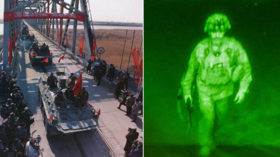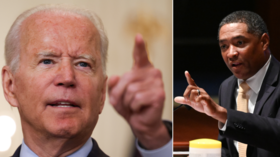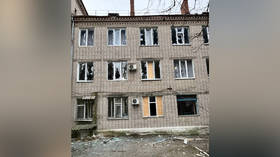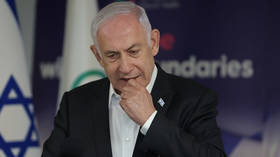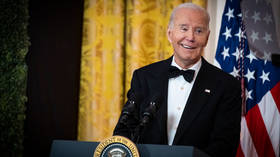‘Over-the-horizon’ is just the newest buzz phrase for American incompetence – as proven by recent drone strikes in Afghanistan
Following the Kabul airport attack, the US military conducted two “over-the-horizon” air strikes against suspected ISIS-K targets. The results inspire zero confidence in the efficacy of this approach toward counterterrorism.
The August 26 suicide bombing outside Hamid Karzai International Airport in the Afghan capital killed more than 150 people, including 13 American troops. The Islamic State-Khorasan, or ISIS-K, claimed responsibility for the attack.
That night, in a televised address to the American people, President Joe Biden declared “We will not forgive. We will not forget. We will hunt you down and make you pay,” adding that the US “will respond with force and precision at our time, where we choose and when we choose.”
The next day, August 27, the US carried out what it termed an “over-the-horizon” attack against an ISIS-K “planner” and “facilitator” at a home in the city of Jalalabad in Nangarhar Province in eastern Afghanistan, killing both men and, according to the US, wounding a third accomplice.
US defense sources sources said the men were killed by a special variant of the Hellfire missile, known as the R9X, or ‘flying Ginsu’, a reference to the six blade-like devices which emerge from the missile, killing its target by cutting it to shreds in lieu of the normal high explosive payload carried by the Hellfire. The R9X was developed specifically to handle situations such as the one in Jalalabad, where legitimate targets have taken refuge among a civilian population.
Also on rt.com ‘BURN IN HELL’: Families of slain troops RAGE at Biden as Facebook suspends grieving mother after angry posts aimed at presidentAccording to reports, the “planner” and “facilitator” were traveling in a three-wheeled vehicle common to the region as public transportation. The men were tracked by an MQ-9 ‘Reaper’ drone which maintained sufficient “eyes and knowledge” of the target to confirm their identities. The three-wheeled vehicle entered a compound believed to be the home of the “planner.” Reportedly, US personnel monitoring the live video images coming from the MQ-9 drone waited until the planner’s wife and children left the compound before launching the ‘flying Ginsu’.
“Initial indications are that we killed the target,” a CENTCOM spokesperson said. “We know of no civilian casualties.” The strike was reportedly authorized by President Biden and ordered by Secretary of Defense Lloyd Austin.
The US assertions about casualties were contradicted by a Jalalabad community elder, Malik Adib, who declared that three people were killed and four were wounded in the drone strike, noting that “women and children are among the victims.”
If the statements of Malik Adib are to be believed, then something went very wrong with the analysis of the imagery used to justify the launching of the missile. While no one has questioned the validity of the US claims that the targets struck were in fact affiliated with ISIS-K (while keeping in mind the US has provided no evidence that corroborates its claim that they were, in fact, ISIS-K operatives), either someone is lying about waiting for the wife and children to leave, or there were other civilians in the vicinity of the attack, one of whom was killed.
Before the media could press the Pentagon about the apparent inconsistencies in the official US account, however, the US launched a second drone strike, this time targeting a vehicle in Kabul, eliminating “an imminent ISIS-K threat” to Hamid Karzai International Airport. According to US officials, the existence of a “large secondary explosion” at the scene of the attack confirmed the assessment about the existence of a car bomb. It is not known if the US used a conventional Hellfire or one of the non-explosive RX9 variants in the attack.
Also on rt.com US airstrike hits suicide bomber vehicle posing ‘imminent threat’ to Kabul airport - PentagonAccording to unnamed defense sources, the alleged ISIS-K operatives inside the vehicle had been observed placing what was assessed to be a considerable amount of explosives in the trunk of a white Toyota Corolla, before driving the vehicle into the driveway of a home located near the airport. The decision was made to strike, resulting in the destruction of the vehicle. US officials claimed that at least one ISIS-K suicide bomber was killed in the incident. Allegedly, nine civilians also perished as a result of the attack.
“We are aware of reports of civilian casualties,” Major General William Taylor, a spokesperson for the Joint Staff, told the media on Monday. “We take these reports extremely seriously.”
Also on rt.com US military says Kabul strike targeting ISIS-K may have led to ‘additional casualties’ amid reports that family of 9 perishedThe driver of the vehicle, Zemari Ahmadi, did not fit the profile one would expect of an ISIS-K suicide bomber. Zemari worked for an American-based charity called Nutrition and Education International.
According to his family, he was on his way home from work after dropping off colleagues on Sunday evening. As he pulled into the driveway of his home, where he lived with three brothers and their families, the children of his relatives ran out to greet him. The missile believed to be launched by the American drone struck the rear of the vehicle, killing Zemari and nine others, including seven children, the youngest of whom was two years old. Also killed was Zemari’s nephew, Ahmad Naser, who had previously served as a guard at a US military facility in Herat, and who was awaiting final approval of his Special Immigrant Visa paperwork so that he could leave Afghanistan.
“No military on the face of the Earth works harder to avoid civilian casualties than the United States military,” Pentagon spokesman John Kirby said after reports emerged about possible civilian casualties. “We take it very, very seriously. And when we know that we have caused innocent life to be lost in the conduct of our operations, we’re transparent about it.”
Kirby went on to suggest that the civilians were killed as a result of the detonation of the explosives alleged to have been contained in Zemari’s vehicle. At a later press conference, Kirby maintained this position, but refused to release any imagery that would sustain his contention of a powerful secondary explosion.
The drone strike that killed Zemari Ahmadi and his relatives represented the very scenario the Biden administration was trying to avoid when setting up the “over-the-horizon” strike capability used in the two responses to the suicide-bomb attack on Kabul Airport.
Also on rt.com 7 Taliban fighters killed in clashes with Panjshir valley resistance, as challenges remain for new rulers after US exitBack in April, when the totality of the failure that was to mark the US withdrawal from Afghanistan remained unknown (although not unknowable – many military and intelligence professionals anticipated the collapse of the Afghan government, but the Biden White House overrode their concerns in favor of better “optics”), General Frank McKenzie, the Marine commanding US Central Command, responsible for all US forces deployed in the Middle East, Central and South Asia, testified before Congress about his command’s efforts to conduct “over-the-horizon” counterterrorism missions once the US drawdown in Afghanistan was completed.
CENTCOM had a long history of conducting “over-the-horizon” (OTH) operations in support of its counterterrorism mission, using a mix of special operations commandos (i.e., the Bin Laden and Abu al-Baghdadi assaults), manned aircraft (the airstrikes against pro-Iranian militias in Syria and Iraq), and drone strikes, such as that carried out against Qassem Soleimani at Baghdad International Airport in January 2020.
“I don’t want to make light of it, I don’t want to put on rose-colored glasses and say it’s going to be easy to do,” McKenzie told the House Armed Services Committee. Any OTH operations in Afghanistan in a post-US drawdown, McKenzie noted, would require significant intelligence support at a time when US intelligence collection capabilities in Afghanistan were diminished to the point of non-existence. “It will be harder to do that, it is not impossible.”
The bulk of the burden of maintaining this OTH capability would fall on the US system of armed drones, which in the past operated from bases inside Afghanistan, providing them with greater reaction time and longer loiter time over the target. Any post-Afghanistan operation of drones in support of OTH operations would mean operating from bases outside of Afghanistan.
According to acting Air Force Secretary John Roth, the US planned on using existing bases in the region to host the drones, noting that the US operated from Al Udeid Air Base in Qatar, Al Dhafra Air Base in the United Arab Emirates, and Kuwait’s Ali Al Salem and Ahmad al-Jaber air bases. The cost of maintaining this OTH capability for fiscal year 2022 was expected to run somewhere around $10 billion.
Also on rt.com America’s catastrophic miscalculation: 20 years of disaster in Afghanistan, by the numbers (PHOTOS)The Biden White House engaged in a policy review of OTH operations, temporarily placing limits on counterterrorism drone strikes and commando raids, and tightening the approval process for such missions, which had been loosened under the Trump administration.
Biden, according to press reports, was particularly sensitive to the need to limit civilian deaths as it looked into how it would respond to future terrorist threats from Afghanistan and elsewhere in the Middle East. The decision was made to continue the program of drone-based assassination/pre-emptive killing but restrict the ability of field commanders to make the final decision, instead requiring White House permission before any OTH attack could occur.
The MQ-9 drones that were involved in the Jalalabad and Kabul drone attacks were operated out of Al Udeid Air Base in Qatar. The MQ-9 system, however, operates according to what the Air Force calls “remote split operations,” which employs a launch-and-recovery ground control station for takeoff and landing operations at Al Udeid, before passing control of the MQ-9 to a crew based out of Creech Air Force Base in Nevada, which takes control of the aircraft for the remainder of the mission using satellite communication links.
Traditionally, an MQ-9 crew consists of a pilot and a sensor operator, who employ what is known as the Multi-Spectral Targeting System, which integrates an infrared sensor, color/monochrome daylight TV camera, image-intensified TV camera, laser range finder/designator, and laser illuminator, all of which can be viewed together or separately on display screens set up in front of the crew.
The MQ-9 would usually operate as part of an overall “intelligence surveillance reconnaissance” (ISR) package which used a variety of intelligence collection resources to identify and track potential targets. The US drawdown in Afghanistan, however, eliminated most if not all of the supporting infrastructure normally available to the MQ-9 crew to discriminate targets. To help compensate for this loss of capability, the US Air Force developed a special signals intelligence (SIGINT) pod that could be carried by the MQ-9 that provided full-spectrum SIGINT capability to the drone operators, who could now search for, identify and track signals of interest, such as the cell phones, walkie-talkies or satellite phones that comprise the communications network of terrorist organizations like ISIS-K. To better employ this capability, the MQ-9 crew would be supplemented by a linguist who could listen in real time to any conversations of interest, helping with the evaluation of potential targets in terms of both identity and intent.
Also on rt.com WATCH: Taliban ‘celebrates’ last American troops fleeing Afghanistan… ‘firing more ammo than in actual combat’ – RT correspondentIntelligence, properly done, is a combination of art and science which requires those involved to be true subject matter experts in the mission they have been given. Imagery analysts need to understand not only what it is they are seeing, but also what it means. Likewise, linguists monitoring conversations need not only be fluent in the language, but adept at slang and other colloquialisms used by people in their daily conversations. For this reason, the best imagery analysts and intercept linguists have been doing their respective jobs for years and, in doing so, are adept at sifting out the unusual from the normal.
However, the airmen operating the MQ-9 most likely did not have this level of experience and expertise. By way of example, the vehicle Zemari Ahmadi was driving was allegedly tracked as “containers containing explosives” were loaded into its trunk. While there is no doubt that an imagery analyst witnessed items being loaded into the trunk of the vehicle, the key question is what was in those containers. Basic identification signatures for car bombs include the use of bags of fertilizer mixed with diesel oil placed in the trunk of a car. However, were the analysts trained to know that Afghanistan blocked the sale of fertilizer back in 2010 because of its extensive use as a bomb-making material, and that the terrorists instead began using potassium chlorate as the primary bomb making material, and that potassium chlorate is loaded into containers virtually identical to those used to store cooking oil?
Moreover, experienced terrorist operatives, which you would expect to be operating from inside Kabul, would anticipate that their communications are being monitored, and as such never use specific words or phrases that could trigger interest on the part of anyone listening in. As such, it is highly unlikely that Zemari or anyone he might have been communicating with would have spoken about explosives or the intent to build a car bomb. He might, however, state that he is picking up cooking oil. If an experienced linguist intercept specialist were listening in, he or she would be able to discern if this was part and parcel of normal activity, or a deviation from the norm. An inexperienced linguist, however, would not possess such insights, and be prone to reading into Zemari’s words content and intent that did not, in reality, exist.
Also on rt.com UNICEF says SEVEN children were killed in Kabul drone strike that US said targeted ISIS-K terroristsIt is unlikely the public will ever know the truth about what happened in Creech Air Base that led the MQ-9 crew to believe that their targets were affiliated with ISIS-K. Despite John Kirby’s assertions regarding transparency, the US military and intelligence community is loath to discuss the specifics regarding intelligence collection capabilities. Likewise, to what extent the extended chain of approval was involved in modifying these assessments as they made their way up the White House will likewise most likely remain secret, further shielding all involved from the kind of scrutiny that full transparency demands.
The Biden administration has placed its hopes for containing terrorism in a post-Afghanistan drawdown on “over-the-horizon” strike capabilities that the president and his supporters believe adequate for the task of identifying and interdicting terrorists before they can carry out an attack against US interests, all the while reducing the likelihood of unintended civilian casualties. If the experience in Afghanistan proves anything, it is that OTH is no panacea when it comes to counterterrorism.
It also underscores the reality that the US intelligence community and military is prone to see what it wants to see. The time-tested adage of “if the only tool available is a hammer, then every problem looks like a nail” holds true in every respect when it comes to OTH in a counterterrorism role: when the only tool available is an MQ-9 drone operated by crews who are not up to the task of properly identifying and tracking targets, then the only solution will be a Hellfire missile which, when employed, will more often than not kill innocent civilians.
Think your friends would be interested? Share this story!
The statements, views and opinions expressed in this column are solely those of the author and do not necessarily represent those of RT.



